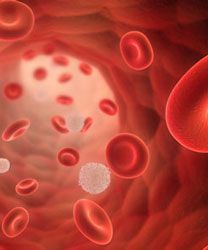Article
Complete Response to Chemo Critical in CLL Patients Who Develop Hodgkin Lymphoma
Author(s):
Achieving a complete response following ABVD chemotherapy offered the best chance for survival for patients with chronic lymphocytic leukemia who developed Hodgkin lymphoma following Richter transformation, according to a retrospective study published in the American Journal of Hematology.

Achieving a complete response (CR) following ABVD chemotherapy offered the best chance for survival for patients with chronic lymphocytic leukemia (CLL) who developed Hodgkin lymphoma (HL) following Richter transformation, according to a retrospective study published in the American Journal of Hematology.
“The achievement of CR with ABVD was the strongest significant and independent predictor of survival,” lead author Francesca Romana Mauro, MD, PhD, and co-investigators wrote. “While the median survival of patients who achieved CR was over 17 years, it was only 7 months for those who failed to achieve a CR.
The Researchers added that a low International Prognostic Score (IPS) and minimum interval of 12 months from the end of prior CLL treatment to a diagnosis of HL, which is a rare variant of RS, were the most important factors determining whether a patient had a complete response.
From July 1994 to December 2015, 33 (0.7%) of 4680 patients with CLL being treated at 10 medical centers in Italy developed biopsy-proven HL. Nearly 80% of patients had stage III/IV disease and half of patients had an IPS of 4 or higher. Median age was 61 at CLL diagnosis and 70 at HL diagnosis. The median interval from CLL to the diagnosis of HL was 90 months (range, 0-258). CLL and HL were diagnosed simultaneously in 3 cases.
More than 80% of patients had been previously treated for CLL prior to the diagnosis of HL and of those, 48% were diagnosed within 12 months of their final CLL treatment. Median number of prior treatments was 2 and 67% of patients had received fludarabine.
Twenty-two patients (66.6%) were treated with the ABVD regimen. Six patients received rituximab (Rituxan) along with ABVD. The median number of administered courses of ABVD was 6 (range, 2-6) and 12 patients (55%) received 6 courses.
The overall response rate (ORR) was 77.3% for patients treated with ABVD, with a CR of 68%. Researchers observed a significantly lower CR rate in patients with an IPS ≥4 compared with those who had IPS ≤3 (27.3% vs 81.8%; P = .03). Patients who were diagnosed with HL within 12 months of their last CLL treatment also had a lower CR rate (45% vs 55%; P = .057). Prior treatment with fludarabine and the addition of rituximab to ABVD did not have a significant effect on CR rate.
Twenty-two patients (64%) in the study died; HL was the cause of death for 15 (71%). Four patients died of infection and 2 died of heart failure. Median survival from HL diagnosis was 37.8 months.
As with CR, treatment with fludarabine and the addition of rituximab to ABVD did not have a significant effect on survival.
“Patients with advanced disease should be investigated by PET/CT and positive lymph nodes should be biopsied,” Mauro, who works in the Department of Cellular Biotechnologies and Hematology at Sapienza University in Rome, Italy, said in an email to OncLive. “This is important to address the correct treatment. Patients who respond to ABVD show a very good prognosis.”
Pallawi Torka, MD, assistant professor of oncology in the Lymphoma & Myeloma Division at Roswell Park Cancer Institute, reviewed the findings for OncLive. She said that treating HL-Richter syndrome (HL-RS) is challenging because patients tend to be elderly, have multiple co-morbidities and poor bone marrow reserve, and are at increased risk for cardiac complications. However, she added that “ABVD is a worthwhile frontline regimen” in patients with good performance status (PS) and a low comorbidity score.
“These findings reiterate the importance of a PET scan and rebiopsy for patients with CLL/SLL [small lymphocytic lymphoma] at the time of relapse, especially if the growth kinetics are more rapid than expected, or if response is incongruent between different sites,” Torka said. “The threshold of using newer therapies such as brentuximab vedotin [Adcetris] and checkpoint inhibitors should be low in patients with borderline PS due to the high infection risk with ABVD in this population. Since most cases of HL-RS are EBV [Epstein-Barr Virus] driven, checkpoint inhibitors have the potential to be highly effective in this condition.
“Patients who fail to achieve a CR with ABVD and have a good PS should be transitioned to salvage high-dose therapy and stem cell transplant, if eligible. The decision regarding autologous stem cell transplant versus allogeneic hematopoietic stem cell transplantation (allo-SCT) is usually highly individualized. While allo-SCT is preferable, as it has a potential to cure the underlying CLL, most patients will not be eligible due to advanced age and comorbidities.”
Mauro FR, Galieni P, Tedeschi A, et al. Factors predicting survival in chronic lymphocytic leukemia patients developing Richter syndrome transformation into Hodgkin lymphoma [published online April 18, 2017]. Am J Hematol. doi: 10.1002/ajh.24714.









